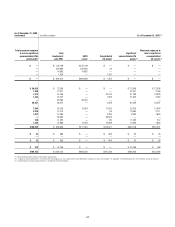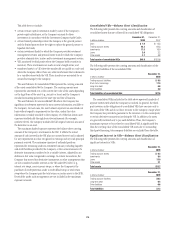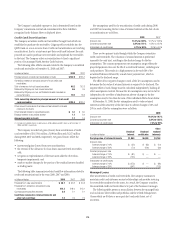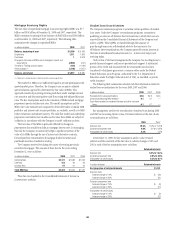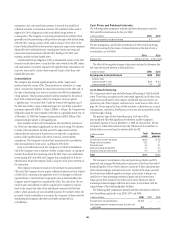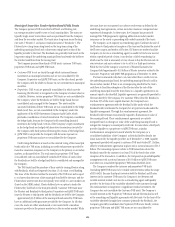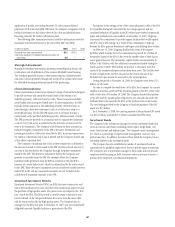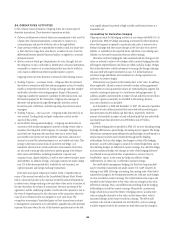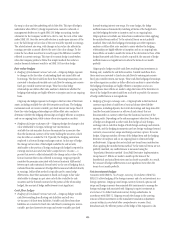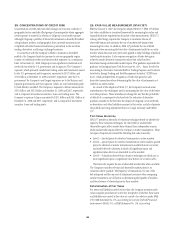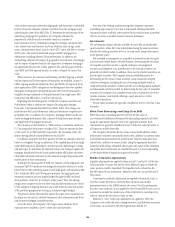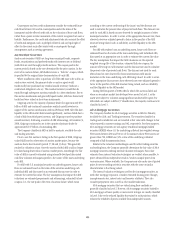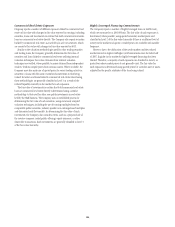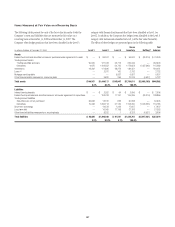Citibank 2008 Annual Report Download - page 193
Download and view the complete annual report
Please find page 193 of the 2008 Citibank annual report below. You can navigate through the pages in the report by either clicking on the pages listed below, or by using the keyword search tool below to find specific information within the annual report.
application of specific accounting literature. For the nonconsolidated
proprietary TOB trusts and QSPE TOB trusts, the Company recognizes only its
residual investment on its balance sheet at fair value and the third-party
financing raised by the trusts is off-balance sheet.
The following table summarizes selected cash flow information related to
municipal bond securitizations for the years 2008, 2007 and 2006:
In billions of dollars 2008 2007 2006
Proceeds from new securitizations $1.2 $10.5 —
Cash flows received on retained interests and other net
cash flows 0.5 ——
Municipal Investments
Municipal investment transactions represent partnerships that finance the
construction and rehabilitation of low-income affordable rental housing.
The Company generally invests in these partnerships as a limited partner
and earns a return primarily through the receipt of tax credits earned from
the affordable housing investments made by the partnership.
Client Intermediation
Client intermediation transactions represent a range of transactions designed
to provide investors with specified returns based on the returns of an
underlying security, referenced asset or index. These transactions include
credit-linked notes and equity-linked notes. In these transactions, the SPE
typically obtains exposure to the underlying security, referenced asset or
index through a derivative instrument, such as a total-return swap or a
credit-default swap. In turn the SPE issues notes to investors that pay a
return based on the specified underlying security, referenced asset or index.
The SPE invests the proceeds in a financial asset or a guaranteed insurance
contract (GIC) that serves as collateral for the derivative contract over the
term of the transaction. The Company’s involvement in these transactions
includes being the counterparty to the SPE’s derivative instruments and
investing in a portion of the notes issued by the SPE. In certain transactions,
the investor’s maximum risk of loss is limited and the Company absorbs risk
of loss above a specified level.
The Company’s maximum risk of loss in these transactions is defined as
the amount invested in notes issued by the SPE and the notional amount of
any risk of loss absorbed by the Company through a separate instrument
issued by the SPE. The derivative instrument held by the Company may
generate a receivable from the SPE (for example, where the Company
purchases credit protection from the SPE in connection with the SPE’s
issuance of a credit-linked note), which is collateralized by the assets owned
by the SPE. These derivative instruments are not considered variable interests
under FIN 46(R) and any associated receivables are not included in the
calculation of maximum exposure to the SPE.
Structured Investment Vehicles
Structured Investment Vehicles (SIVs) are SPEs that issue junior notes and
senior debt (medium-term notes and short-term commercial paper) to fund
the purchase of high quality assets. The junior notes are subject to the “first
loss” risk of the SIVs. The SIVs provide a variable return to the junior note
investors based on the net spread between the cost to issue the senior debt
and the return realized by the high quality assets. The Company acts as
manager for the SIVs and, prior to December 13, 2007, was not contractually
obligated to provide liquidity facilities or guarantees to the SIVs.
In response to the ratings review of the outstanding senior debt of the SIVs
for a possible downgrade announced by two ratings agencies and the
continued reduction of liquidity in the SIV-related asset-backed commercial
paper and medium-term note markets, on December 13, 2007, Citigroup
announced its commitment to provide support facilities that would support
the SIVs’ senior debt ratings. As a result of this commitment, Citigroup
became the SIVs’ primary beneficiary and began consolidating these entities.
On February 12, 2008, Citigroup finalized the terms of the support
facilities, which took the form of a commitment to provide $3.5 billion of
mezzanine capital to the SIVs in the event the market value of their junior
notes approaches zero. The mezzanine capital facility was increased by $1
billion to $4.5 billion, with the additional commitment funded during the
fourth quarter of 2008. The facilities rank senior to the junior notes but
junior to the commercial paper and medium-term notes. The facilities were
at arm’s-length terms. Interest was paid on the drawn amount of the
facilities and a per annum fee was paid on the unused portion.
During the period to November 18, 2008, the Company wrote down $3.3
billion on SIV assets.
In order to complete the wind-down of the SIVs, the Company, in a nearly
cashless transaction, purchased the remaining assets of the SIVs at fair value,
with a trade date of November 18, 2008. The Company funded the purchase
of the SIV assets by assuming the obligation to pay amounts due under the
medium-term notes issued by the SIVs, as the medium-term notes mature.
The net funding provided by the Company to fund the purchase of the SIV
assets was $0.3 billion.
As of December 31, 2008, the carrying amount of the purchased SIV assets
was $16.6 billion, of which $16.5 billion is classified as HTM assets.
Investment Funds
The Company is the investment manager for certain investment funds that
invest in various asset classes including private equity, hedge funds, real
estate, fixed income and infrastructure. The Company earns a management
fee, which is a percentage of capital under management, and may earn
performance fees. In addition, for some of these funds the Company has an
ownership interest in the investment funds.
The Company has also established a number of investment funds as
opportunities for qualified employees to invest in private equity investments.
The Company acts as investment manager to these funds and may provide
employees with financing on both a recourse and non-recourse basis for a
portion of the employees’ investment commitments.
187


